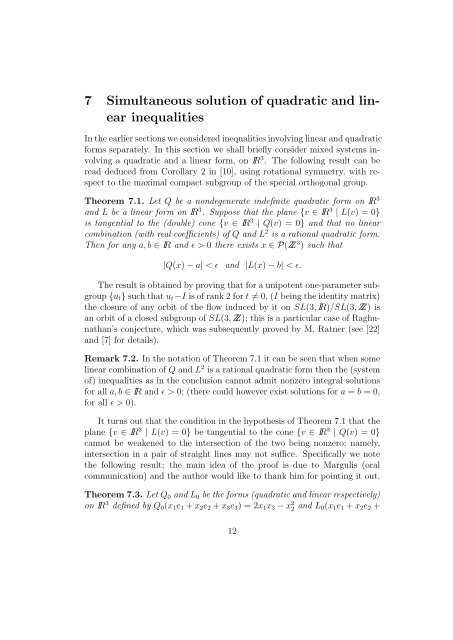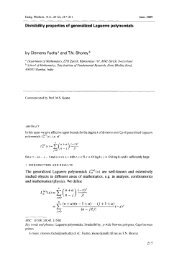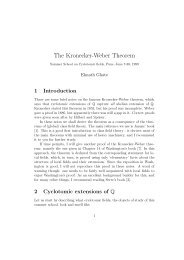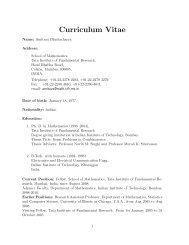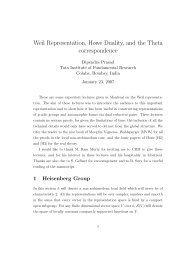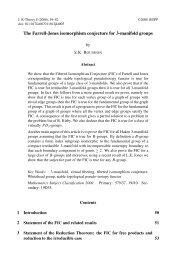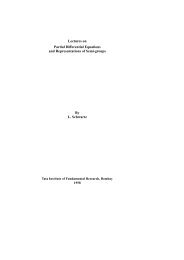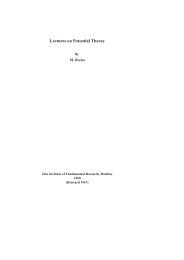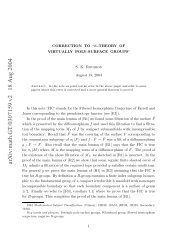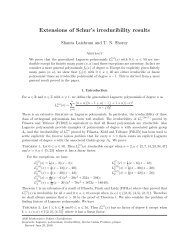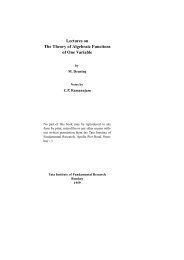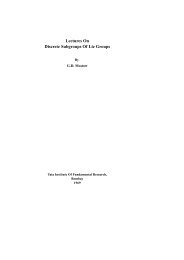On values of linear and quadratic forms at integral points
On values of linear and quadratic forms at integral points
On values of linear and quadratic forms at integral points
You also want an ePaper? Increase the reach of your titles
YUMPU automatically turns print PDFs into web optimized ePapers that Google loves.
7 Simultaneous solution <strong>of</strong> <strong>quadr<strong>at</strong>ic</strong> <strong>and</strong> <strong>linear</strong>inequalitiesIn the earlier sections we considered inequalities involving <strong>linear</strong> <strong>and</strong> <strong>quadr<strong>at</strong>ic</strong><strong>forms</strong> separ<strong>at</strong>ely. In this section we shall briefly consider mixed systems involvinga <strong>quadr<strong>at</strong>ic</strong> <strong>and</strong> a <strong>linear</strong> form, on IR 3 . The following result can beread deduced from Corollary 2 in [10], using rot<strong>at</strong>ional symmetry, with respectto the maximal compact subgroup <strong>of</strong> the special orthogonal group.Theorem 7.1. Let Q be a nondegener<strong>at</strong>e indefinite <strong>quadr<strong>at</strong>ic</strong> form on IR 3<strong>and</strong> L be a <strong>linear</strong> form on IR 3 . Suppose th<strong>at</strong> the plane {v ∈ IR 3 | L(v) = 0}is tangential to the (double) cone {v ∈ IR 3 | Q(v) = 0} <strong>and</strong> th<strong>at</strong> no <strong>linear</strong>combin<strong>at</strong>ion (with real coefficients) <strong>of</strong> Q <strong>and</strong> L 2 is a r<strong>at</strong>ional <strong>quadr<strong>at</strong>ic</strong> form.Then for any a, b ∈ IR <strong>and</strong> ɛ > 0 there exists x ∈ P( Z 3 ) such th<strong>at</strong>|Q(x) − a| < ɛ <strong>and</strong> |L(x) − b| < ɛ.The result is obtained by proving th<strong>at</strong> for a unipotent one-parameter subgroup{u t } such th<strong>at</strong> u t −I is <strong>of</strong> rank 2 for t ≠ 0, (I being the identity m<strong>at</strong>rix)the closure <strong>of</strong> any orbit <strong>of</strong> the flow induced by it on SL(3, IR)/SL(3, Z) isan orbit <strong>of</strong> a closed subgroup <strong>of</strong> SL(3, Z); this is a particular case <strong>of</strong> Raghun<strong>at</strong>han’sconjecture, which was subsequently proved by M. R<strong>at</strong>ner (see [22]<strong>and</strong> [7] for details).Remark 7.2. In the not<strong>at</strong>ion <strong>of</strong> Theorem 7.1 it can be seen th<strong>at</strong> when some<strong>linear</strong> combin<strong>at</strong>ion <strong>of</strong> Q <strong>and</strong> L 2 is a r<strong>at</strong>ional <strong>quadr<strong>at</strong>ic</strong> form then the (system<strong>of</strong>) inequalities as in the conclusion cannot admit nonzero <strong>integral</strong> solutionsfor all a, b ∈ IR <strong>and</strong> ɛ > 0; (there could however exist solutions for a = b = 0,for all ɛ > 0).It turns out th<strong>at</strong> the condition in the hypothesis <strong>of</strong> Theorem 7.1 th<strong>at</strong> theplane {v ∈ IR 3 | L(v) = 0} be tangential to the cone {v ∈ IR 3 | Q(v) = 0}cannot be weakened to the intersection <strong>of</strong> the two being nonzero; namely,intersection in a pair <strong>of</strong> straight lines may not suffice. Specifically we notethe following result; the main idea <strong>of</strong> the pro<strong>of</strong> is due to Margulis (oralcommunic<strong>at</strong>ion) <strong>and</strong> the author would like to thank him for pointing it out.Theorem 7.3. Let Q 0 <strong>and</strong> L 0 be the <strong>forms</strong> (<strong>quadr<strong>at</strong>ic</strong> <strong>and</strong> <strong>linear</strong> respectively)on IR 3 defined by Q 0 (x 1 e 1 + x 2 e 2 + x 3 e 3 ) = 2x 1 x 3 − x 2 2 <strong>and</strong> L 0 (x 1 e 1 + x 2 e 2 +12


